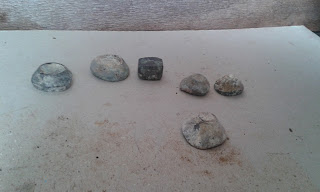Being probably the only ones in existence, would make these Gold bars #heritage items .
http://geoscience69.blogspot.com/
Mt Morgan Mine Antiques from the years mainly 1885 to 1932 when Flooding and cave ins closed it for a period of time. the first years of the 1800's was it richest producing times. Gold bars for shipping were produced the size of 4ounze to 7 ounce was a way of keeping the shipping item into easy manageable size goods. The 4 bars above are what you can find in some shipwreck treasures but only 8 to 9 ct as Mt Morgan mine had not perfected use of its smelters and this can problem was at the beginning of the process as it is shown with the slag heaps near mundic gully.
Assaying was a very technical business where the molten ore was turned into ingots, the Blister copper silver lead gold ingots were put in a clay ware crucible and a piece of lead on top a super-hot iron bar was inserted the heat fused the lead and gold together to make a lead gold glass ingot called a dore, The dore was put in a clayware cuplet in a oven hot air was injected forcing the lead into the clay leaving a gold bead behind which was weighed as the percentage assay.
The only 2 Large Clayware crucibles of this type I have found.
Clayware Crucibles Smaller left is a rare type only a dozen found, next is the most common and probably the last type used as it was abundant in top levels whereas the next three a long narrow one with lip and stone ware one with letter on base al come from deeper layers. The clayware variety were made by a company in Bendigo Vic, the stoneware ones have stamped bases which leaves me to believe they were mad n England, four are all sold by me but 3 is what I can fit in box for $22 contact me mjknight6@bigpond.com for invoice, see my ebay listings below crucibles and ingots are sometimes listed.
Batterseas Works London stamped on base small ones 3 in center and large variety 3 1/2 which indicates they held that many ounces of gold. Made out of oven backed clay 1895. I have 3-ounce stamped ones for sale.
Large 3 1/2 Batterseas works London crucibles.
Batterseas works London crucibles. very rare only found this amount.
Newbold Warrath NSW very rare also only have these few all found together near the fence.
Small clayware crucibles again only found these 3.
Chinese porcelain crucibles only this many unbroken most were broken.
Indian made as stamped on some of these Clayware cuplets these were used to absorb the lead from the small lead gold ingots or dores, these were put in furnace and removed with tongs the process produced a weighable bead of gold to determine the content of the gold in the large copper rail sleeper size bars exported.
Small crucibles which I researched to have been made by Plumbago Co England in 1883 these were used to produce the bead of gold from the lead gold glass ore.
Clayware cuplets probably the most abundant and easily damaged by the weather and other acids in the dump as ost were cracked and damaged and having a large lead content best kept in sealed dry conditions.
Lead Gold Glass ingot/Dore separation of ores was done by absorption of lead by cuplet and small crucibles.
A cast iron Ingot maker.
Cast spoons for molten metal.
A few of the ingots produced the glass ones I can't find any information on, but I am to believe it was produced by the ingot cast cleaning molten silica was pour in and it absorbed the color and the waste out of the iron hence the color green.
Bottles and a part of a centrifuge used at the Laboratory down near the river which was later the power station. The mine produced its own power while the workers still used Kero lamps.
Drill cores and other samples of rocks that were processed.
Samples of slag waste that in the early years had lots of iron and some copper the first furnaces were not efficient, and much gold was wasted later the slag was just a glass like waste.
Lots of different furnace bricks for the 1800's era.































































Comments
Post a Comment